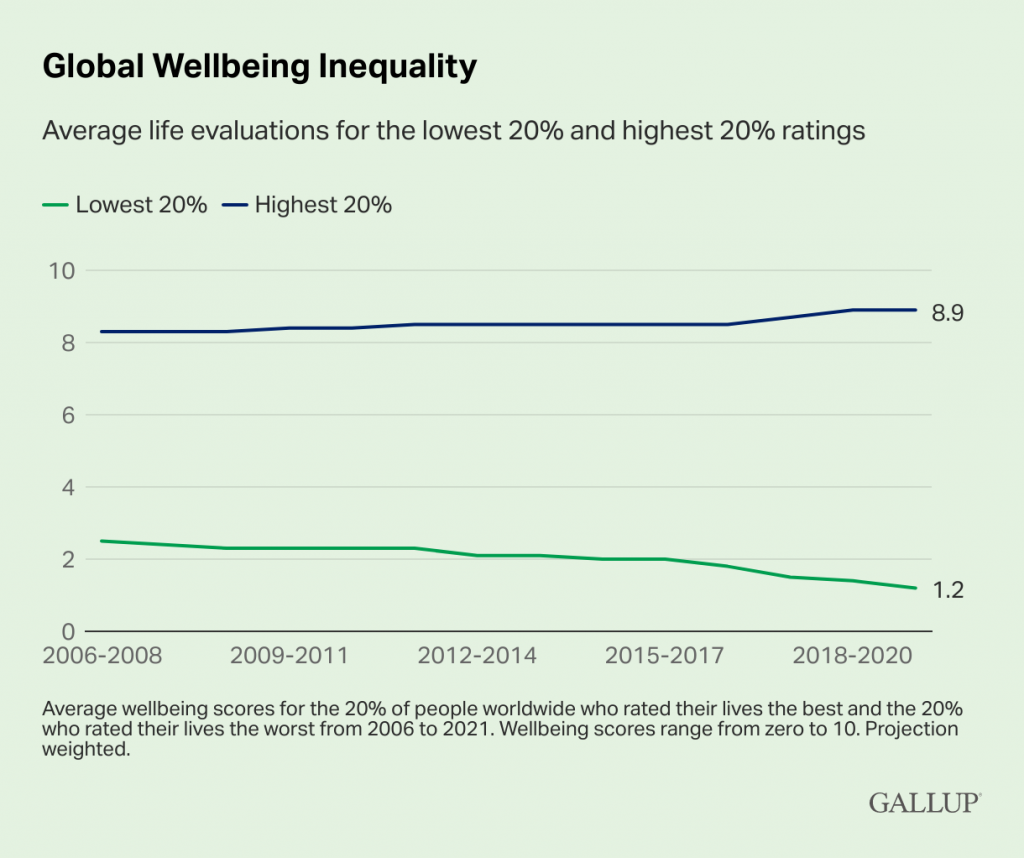Unhappiness has been on the rise around the globe across the past 10 years, Gallup reports.
This rise in unhappiness runs deeper than the worldwide dread felt during and after the COVID-19 pandemic. It has been brewing for quite some time, and Gallup proposes a few reasons why.
Although rising income inequality and poverty’s impact on overall levels of well-being play a role in rates of unhappiness, Gallup believes this is not the primary reason people are unhappy.
The 20% of people who reported having the highest levels of happiness cited five reasons why: “They are fulfilled by their work, have little financial stress, live in great communities, have good physical health and have loved ones they can turn to for help,” Gallup says in the release of its findings.
In contrast, the 20% of people who reported having the highest levels of unhappiness “have very little of any of those things,” Gallup explains. “They don’t have a quality job, their income is not enough to get by, they live in broken communities, they are hungry or malnourished, and they don’t have anyone in their life they can count on for help.”
Unhappiness factors
Gallup has concluded the global rise in unhappiness is caused by a mixture of things.
The collective inability to find jobs that people enjoy and are financially sustained by causes everything from general dissatisfaction to extreme economic stress.
The collective inability to find jobs that people enjoy and financially sustain them causes everything from general dissatisfaction to extreme economic stress. Unhappy individuals tend to lack community and have a deficit of people to whom they can go for support. To top it off, many people have poor health and well-being because paying bills is more urgent than buying healthy food or going to the doctor, and mental health care is expensive but seldom covered adequately by medical insurance — which 27.2 million Americans do not have.

How can we flatten this curve?
Tyler VanderWeele, director of the Human Flourishing Program at Harvard University’s Institute for Quantitative Social Science, produces multiple publications that discuss how to promote measurable factors of human well-being, including how religious attendance impacts levels of human flourishing.
In his 2020 publication, Activities for Flourishing: An Evidence-Based Guide, VanderWeele discusses how a variety of cognitive and behavioral exercises, such as regularly practicing gratitude or engaging in acts of kindness, provide positive long-term impacts on a person’s quality of life. He also discusses how some institutional commitments – work, marriage and religious community – can help facilitate flourishing.
Ways to improve
This research illustrates many ways a person can improve quality of life, depending on specific situations and struggles. For some, exercises carried out on an individual basis — such as journaling or going on reflective walks — may be helpful. However, people who engage in communal activities, intentionally sharing their lives with others, enjoy a significant impact.

Tyler VanderWeele
Discussing religious communities, VanderWeele notes religious service attendance promotes human flourishing, because it provides an outlet for community and relationships.
But as regular church attendance continues to decrease, will religious communities continue to serve as places that facilitate measurable increases in happiness? Or has the shift away from Sunday mornings as weekly times of in-person worship and fellowship contributed in part to the global decrease in happiness?
Of course, the church is limited in its ability to alleviate poverty, economic stress or medical problems, which Gallup cites as major causes for the last decade’s rise in unhappiness. But the church does address the lack of community many people experience.
In his 2017 publication, Religious Communities and Human Flourishing, VanderWeele discusses data that show religious service attendance provides a positive impact on both physical and mental health, with a 25% to 35% reduction in mortality rates, as well as 20% to 30% lower rates of depression, among people who attend services regularly.
Church attendance even increases the likelihood a person might seek out nonreligious community activities.
Regular attenders also enjoy better social relationships. Their congregations offer space in which they can make new friends and feel supported. And church attendance even increases the likelihood a person might seek out nonreligious community activities.
Faith and hope
Religious service attendance also positively correlates with overall happiness and life satisfaction, and with a sense of meaning and life purpose, perhaps due to church teachings on faith and hope, VanderWeele reports.
Religious service participants are more likely than others to be virtuous, he adds. More often than others, they engage in charitable giving, volunteer and are overall more civically engaged. Likewise, they are less likely to be involved in crime.

This connection between religion and well-being points to two possible explanations that likely work together — church teachings that promote a sense of value for self and community, as well as social relationships and community support provided by church attendance.
A 2019 survey conducted by the Pew Research Center also found this to be true. In many countries including the United States, adult respondents who were active members of religious congregations reported higher levels of happiness and civic engagement than religious adults who were inactive in congregational activities as well as religiously unaffiliated adults.
Multiple factors
This study also cites a long-held correlation between religiosity and good health, with many Americans who regularly attend religious services living longer than others. This may be due to multiple factors, such as the reduced prevalence of smoking and drinking among Christians in America. As patients find solace in prayer and spirituality, religiosity also can help alleviate stress, preventing the release of hormones that hinder the body’s ability to get better.
However, studies specifically relating to religion and health show mixed results. Some studies note religion and health sometimes may have a negative relationship, particularly related to high rates of obesity among highly religious Americans.
Overall, religious service attendance seems to have a positive impact on the overall happiness and life satisfaction of those who participate. And as global levels of unhappiness continue to rise while church attendance continues to fall, what role will religion play in the future of global well-being?
Mallory Challis is a senior at Wingate University and serves as BNG’s Clemons Fellow.
Related articles:
Who knew ‘unalienable rights’ could undermine life, liberty and true happiness?
Finding an alternative to the anxious pursuit of happiness parading as American Christianity
Religion may aid ‘Sustained Happiness’
Spending money brings happiness. But what kind of spending?


